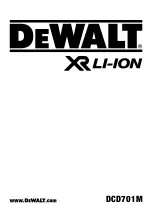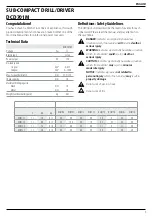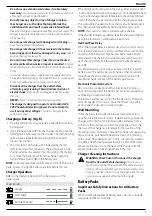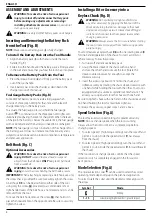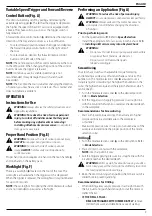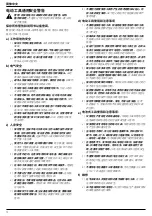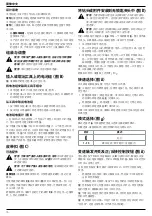
4
English
Safety Instructions for All Operations
•
Hold power tool by insulated gripping surfaces, when
performing an operation where the cutting accessory or
the fastener may contact hidden wiring.
Cutting accessory
or the fastener contacting a “live” wire may make exposed
metal parts of the power tool “live” and could give the operator
an electric shock.
Safety Instructions When Using Long
Drill Bits
•
Never operate at higher speed than the maximum
speed rating of the drill bit.
At higher speeds, the bit is likely
to bend if allowed to rotate freely without contacting the
workpiece, resulting in personal injury.
•
Always start drilling at low speed and with the bit tip
in contact with the workpiece.
At higher speeds, the bit is
likely to bend if allowed to rotate freely without contacting the
workpiece, resulting in personal injury.
•
Apply pressure only in direct line with the bit and do not
apply excessive pressure.
Bits can bend causing breakage or
loss of control, resulting in personal injury.
Additional Safety Warnings for Drills
•
Use clamps or other practical way to secure and support
the workpiece to a stable platform.
Holding the work by
hand or against your body is unstable and may lead to loss
of control.
•
Accessories and tool may get hot during operation.
Wear
gloves when handling them if performing heat producing
applications such as drilling metals.
•
Air vents often cover moving parts and should be
avoided.
Loose clothes, jewelry or long hair can be caught in
moving parts.
Residual Risks
In spite of the application of the relevant safety regulations
and the implementation of safety devices, certain residual risks
cannot be avoided. These are:
• Impairment of hearing.
• Risk of personal injury due to flying particles.
• Risk of burns due to accessories becoming hot
during operation.
• Risk of personal injury due to prolonged use.
SAVE THESE INSTRUCTIONS
Chargers
D
e
WALT
chargers require no adjustment and are designed to be
as easy as possible to operate.
Electrical Safety
The electric motor has been designed for one voltage only.
Always check that the battery pack voltage corresponds to the
voltage on the rating plate. Also make sure that the voltage of
your charger corresponds to that of your mains.
Your
D
e
WALT
charger is double insulated in
accordance with IEC60335; therefore no earth wire
is required.
If the supply cord is damaged, it must be replaced by a
specially prepared cord available through the
D
e
WALT
service organisation.
Using an Extension Cable
An extension cord should not be used unless absolutely
necessary. Use an approved extension cable suitable for
the power input of your charger (see
Technical Data
). The
minimum conductor size is 1 mm
2
; the maximum length
is 30 m.
When using a cable reel, always unwind the cable completely.
Important Safety Instructions for All Battery
Chargers
SAVE THESE INSTRUCTIONS:
This manual contains important
safety and operating instructions for compatible battery
chargers (refer to
Technical Data
).
• Before using charger, read all instructions and cautionary
markings on charger, battery pack, and product using
battery pack.
WARNING:
Shock hazard. Do not allow any liquid to get
inside charger. Electric shock may result.
WARNING:
We recommend the use of a residual current
device with a residual current rating of 30mA or less.
CAUTION:
Burn hazard. To reduce the risk of injury,
charge only
D
e
WALT
rechargeable batteries. Other types of
batteries may burst causing personal injury and damage.
CAUTION:
Children should be supervised to ensure that
they do not play with the appliance.
NOTICE:
Under certain conditions, with the charger
plugged into the power supply, the exposed charging
contacts inside the charger can be shorted by foreign
material. Foreign materials of a conductive nature such
as, but not limited to, steel wool, aluminum foil or any
buildup of metallic particles should be kept away from
charger cavities. Always unplug the charger from the
power supply when there is no battery pack in the cavity.
Unplug charger before attempting to clean
•
DO NOT attempt to charge the battery pack with any
chargers other than the ones in this manual.
The charger
and battery pack are specifically designed to work together.
•
These chargers are not intended for any uses other than
charging
D
e
WALT
rechargeable batteries.
Any other uses
may result in risk of fire, electric shock or electrocution.
•
Do not expose charger to rain or snow.
•
Pull by plug rather than cord when disconnecting
charger.
This will reduce risk of damage to electric plug
and cord.
•
Make sure that cord is located so that it will not be
stepped on, tripped over, or otherwise subjected to
damage or stress.

